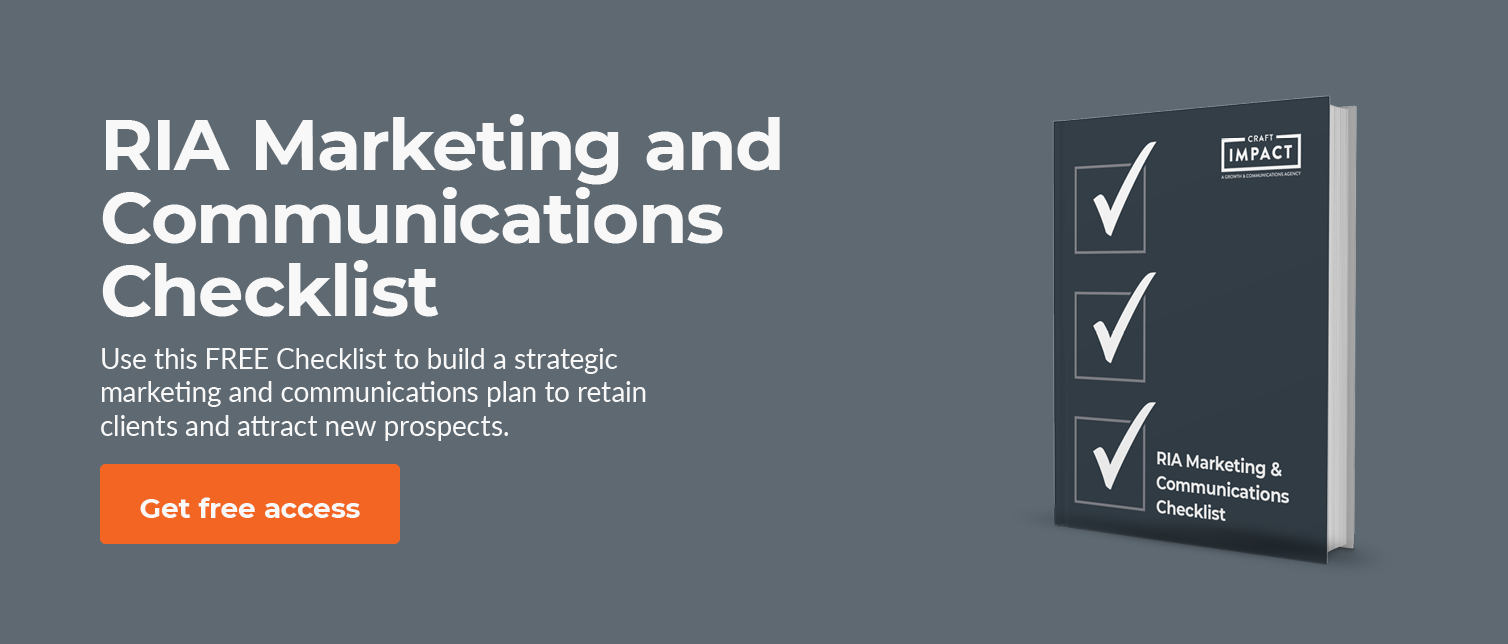It is the life blood of your bottom line and the instrument which forges the connection between your services offered and the outside world.
A clear messaging strategy is essential for your continued development and growth. You need to know where you are heading as a practice and how to best communicate with the groups who drive a successful bottom line: your current clients and prospective clients.
- Who are my current clients, and why did they choose my financial practice?
- Who are my ideal prospective clients, and what are their external and internal problems that I can help solve?
- What is the best way to reach my ideal clients, and how do they prefer to be communicated with?
- What’s the most effective way to talk to my current and prospective ideal clients?
Understanding the answers to these questions helps you build trust and rapport with your current and prospective clients - a vital step in either retaining or gaining their business.
What’s the best framework to build a clear and compelling messaging strategy for your financial advisor practice?
StoryBrand - A Clear Framework to Clarify Your Messaging
StoryBrand is a framework that will guide and shape the way you talk about who you are, what you do and the unique value you bring to the table.
StoryBrand simplifies your core mission into an easy-to-digest form that can be understood by people inside and outside of your practice.
StoryBrand helps you turn your service and offerings into compelling words and phrases that captivate your current clients and prospective ideal clients.
How?
StoryBrand flips the script and places your client as the hero of the story
How StoryBrand Turns Your Financial Advisor Clients into Heroes
1. What does the character want?
Participants always seemed to be a bit shocked by the first StoryBrand messaging workshop exercise. Advisors come in talking about what programs and services they offer to clients, and this approach is quickly flipped on its head.
Your financial practice is not the hero of this story. Your advisors are not the heroes of the story.
Your clients are the heroes of this story (current and prospective).
As the main characters of this story, we need to examine: what do your clients want? What are their thoughts, attitudes, and desires related to your industry? What do they want to get out of working with someone like you?
Is your ideal client seeking peace of mind for their family? Or are they most concerned about growing their wealth quickly?
Treating your client as the character in this hero’s journey helps you better understand where they are coming from. This gives you the ability to cater your messaging directly to them, in a compelling way.
2. What gets in the character’s way, and how does it make them feel?
We continue the deep dive into the character or hero of the story’s motivations and aspirations.
The client wants something, but something gets in the way. A problem. What is that core problem?
What is the problem your client will face over and over again in your industry?
Perhaps it is not being treated with respect in a way that values them as people. Or they hear the same thing, every time, regardless of their unique situation.
Once your hero’s problem has been identified, let’s talk about how it makes them feel.
Knowing not only the details of your client’s problems, but also how it makes them feel, allows you to both act like an authority in your industry and someone who can show empathy to your client.
3. You are the guide. How do you show empathy to the character?
After you have explored your client’s desires and motivations, problems and feelings, it is now time for you, the guide, to enter the story.
How do you, as the character or hero’s guide, demonstrate empathy in your approach to the client’s problem? How do you help solve the client’s problem in a way that incorporates their thoughts and feelings into the equation?
StoryBrand’s focus on empathy is one of the key differentiators that sets it apart from other messaging frameworks as a way that speaks directly to your clients.
Empathy is the way you develop a compelling message that calls your clients to action.
4. You are the guide. How do you show authority to the character?
It is important to incorporate your client’s thoughts and feelings into helping them solve their problems, but you also actually need to demonstrate that you are able to solve their problem.
After all, they are turning to your practice and your industry because they believe you have a certain level of expertise in this field.
How will you demonstrate authority as a financial practice and give your clients the confidence that you are going to be able to help them achieve what they want?
In this part of the StoryBrand messaging workshop, participants spend time discussing their level of expertise, tools, and experience that separate them from their competitors and help their clients succeed.
5. What is the plan to help the character get what they want?
You now know the main character, the hero, in this story and what they are trying to accomplish.
You have worked to articulate how you, as the empathetic and authoritative guide, can solve the hero’s problem in a way that speaks directly to them.
But what will the hero’s journey look like?
How will you, as the guide, put together scaffolded stepping stones to allow the hero (your client) to reach their goals?
This is usually a 3-step process that is written clearly and concisely in a way that can be used with clients. It starts with the normal intake process for new clients and moves towards how the clients will be given value each step of the way.
In reviewing this simplified process, a new client should have a clear understanding of how they will be able to get what they want by following your plan.
6. What is the character’s call-to-action?
The story has been told, and all the steps have been laid out.
What's next?
One of the key elements of the StoryBrand workshop, the character or hero is “called to action” and asked to do something to help them move forward in the journey or sales process.
There are two different types of “Calls to Action” or “CTAs.” A primary Call to Action or CTA compels the client to connect directly with a representative at your practice. While the primary CTA is most often a phone call in the financial advisor space, i.e. “Call Us!”, it can also be a request to fill out a contact form or set up a meeting. The StoryBrand workshops help define what the primary CTA should be and how it will be integrated with the overall messaging strategy.
Some prospective clients will not be ready to move forward with the primary CTA. They may have an interest in your financial practice and recognize that it could be beneficial for them, but they are simply not ready to talk on the phone or set up a meeting. For these prospects, an important question must be answered, “What tool or important information can I offer to the prospective client at this stage that will add value to their lives?” The tool or important information that answers this question is called a “transitional” Call to Action or CTA.
A transitional CTA helps bridge the gap between the primary CTA (connecting directly with the business) and the current stage of the prospective client. It is a high quality, premium piece of content that provides value to the prospective client’s life and continues to build a positive relationship. The “action”- usually filling out a form and downloading the content, brings them closer to the stage where they are ready to speak directly with you.
Common transitional CTAs in the financial services industry include free courses on money management, whitepapers on “saving for college,” and checklists for “preparing for retirement.”
Embracing Your New StoryBrand Messaging Strategy as a Financial Practice
 The StoryBrand messaging workshops generate a 1 page narrative or BrandScript for each of the heroes or characters (ideal clients) that have been discussed throughout the process.
The StoryBrand messaging workshops generate a 1 page narrative or BrandScript for each of the heroes or characters (ideal clients) that have been discussed throughout the process.
These narratives also generate important messaging themes or key phrases that can be used with potential clients when designing any type of sales materials. Think website language, premium .pdf whitepapers, or even scripts for talking to new clients on the phone/through Zoom.
These messages or key phrases are vital to providing everyone in the financial practice with a uniform language in talking to prospective clients. They are simple too - they can be easily referenced based on what theme is most relevant at the time.
And you know the themes work. You know they are compelling. You know they speak in an empathic and authoritative way to your potential clients.
You know this because you’ve done the work to put in the time to think through your client’s heroic journey.
The first way you can embrace your new StoryBrand messaging strategy is by sharing it with your employees and anyone who talks to current or potential clients. The StoryBrand narratives and key words/phrases are meant to permeate your organization’s thoughts, words, and actions.
Next, it’s time to get down into the nitty gritty.
Now that you know what you need to say and how to say it, it’s time to develop a comprehensive digital content marketing strategy for your practice. You have an updated messaging filter, a filter through which to run all of your marketing, sales, and communications materials.
It’s time to run your current marketing, sales, and communications materials through your updated messaging filter - and develop new ones if needed. We can now engage prospects, current clients, and key stakeholders better than ever before - let the marketing and sales strategy begin!
Looking to partner with Craft Impact to clarify your messaging strategy and grow your financial practice?



